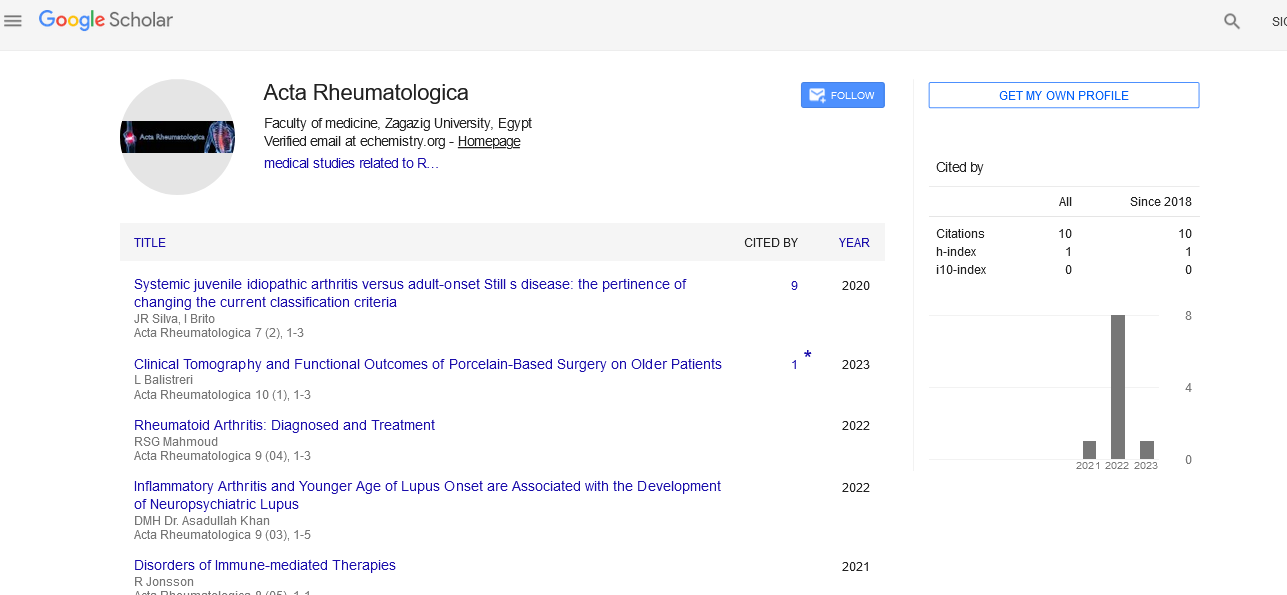Perspective - (2024) Volume 11, Issue 4
Fibromyalgia: Deciphering the Enigma of Chronic Pain and Its Management
Valentina Vanini*
Department of Science, University of Verona, Verona VR, Italy
*Correspondence:
Valentina Vanini, Department of Science, University of Verona, Verona VR,
Italy,
Email:
Received: 16-Jul-2024, Manuscript No. IPAR-24-15058;
Editor assigned: 19-Jul-2024, Pre QC No. IPAR-24-15058 (PQ);
Reviewed: 02-Aug-2024, QC No. IPAR-24-15058;
Revised: 12-Aug-2024, Manuscript No. IPAR-24-15058 (R);
Published:
20-Aug-2024
Introduction
Fibromyalgia stands as one of the most perplexing chronic
pain conditions, affecting millions globally with its pervasive
symptoms and complex management challenges. This article
seeks to unravel the intricate nature of fibromyalgia, delving
into its definition, symptoms, potential causes, diagnostic
process, treatment options, and the latest research insights
aimed at improving the lives of those affected by this often
misunderstood syndrome.
Description
Understanding fibromyalgia
Fibromyalgia is characterized by widespread musculoskeletal
pain, accompanied by tenderness in specific areas of the body,
often referred to as tender points. Beyond pain, individuals with
fibromyalgia commonly experience fatigue, sleep disturbances,
cognitive difficulties (referred to as "fibro fog"), headaches, and
mood disturbances such as anxiety and depression. The
condition can vary greatly in severity and impact, fluctuating
over time and presenting unique challenges to both patients and
healthcare providers.
Causes and risk factors
The exact cause of fibromyalgia remains elusive, but
researchers believe it involves a combination of genetic,
physiological, and environmental factors. Possible triggers or
contributors may include:
Genetic predisposition: Family history of fibromyalgia or
related conditions.
Physical trauma: Injuries, accidents, or repetitive stress
injuries that may trigger or exacerbate symptoms.
Infections: Some infections have been linked to the onset of
fibromyalgia symptoms.
Psychological factors: Stress, anxiety, and trauma may play a
role in the development or worsening of symptoms.
Central sensitization: Abnormalities in how the brain and
spinal cord process pain signals, leading to heightened sensitivity
to pain.
Women are disproportionately affected by fibromyalgia, with
the condition typically diagnosed in middle adulthood, although
it can occur at any age.
Symptoms of fibromyalgia
The hallmark symptom of fibromyalgia is chronic widespread
pain, which affects both sides of the body and often includes
areas such as the neck, shoulders, back, and hips. Other
common symptoms include:
Fatigue: Persistent, unexplained tiredness that is not relieved
by rest or sleep.
Sleep disturbances: Difficulty falling asleep, staying asleep, or
waking feeling unrefreshed.
Cognitive difficulties: Memory problems, difficulty
concentrating, and impaired mental clarity.
Mood disorders: Anxiety, depression, and changes in mood
that may accompany chronic pain and fatigue.
Other symptoms: Headaches, Irritable Bowel Syndrome (IBS),
Temporomandibular Joint (TMJ) disorders, sensitivity to light,
sound, or temperature changes.
The variability and overlap of symptoms often complicate
diagnosis and treatment planning.
Diagnosis
Diagnosing fibromyalgia can be challenging due to the absence
of specific diagnostic tests and the overlap of symptoms with
other conditions. Healthcare providers typically rely on a
combination of clinical evaluation and patient-reported
symptoms. Key aspects of the diagnostic process include:
Medical history: Detailed discussion of symptoms, their onset,
duration, and impact on daily life.
Physical examination: Identifying tender points or areas of
pain sensitivity across the body.
Diagnostic criteria: The American College of Rheumatology
(ACR) criteria, which include widespread pain lasting at least
three months and tenderness in at least 11 of 18 specified
tender points. However, newer guidelines emphasize symptom
assessment and may not require tender point examination.
Laboratory tests: Blood tests to rule out other conditions with
similar symptoms, such as autoimmune diseases, thyroid
disorders, or vitamin deficiencies.
A multidisciplinary approach involving rheumatologists, pain
specialists, and other healthcare providers is often necessary to
confirm the diagnosis and develop an effective treatment plan.
Treatment options
Management of fibromyalgia aims to alleviate symptoms,
improve quality of life, and enhance overall functioning.
Treatment strategies are individualized based on symptom
severity and patient preferences and may include:
Medications: Pain relievers such as acetaminophen or NSAIDs
for mild pain, antidepressants (such as duloxetine or
amitriptyline) to improve sleep and mood, and anti-seizure
medications (such as pregabalin or gabapentin) to reduce nerve-related
pain.
Cognitive Behavioral Therapy (CBT): Helps individuals develop
coping strategies, manage stress, and improve sleep patterns.
Physical therapy: Exercises to improve strength, flexibility,
and stamina, as well as techniques such as massage therapy or
acupuncture for pain relief.
Lifestyle modifications: Establishing a regular sleep schedule,
practicing relaxation techniques (such as yoga or meditation),
pacing activities to avoid overexertion, and maintaining a
balanced diet to support overall health.
Combining these approaches into a comprehensive treatment
plan can help individuals with fibromyalgia better manage their
symptoms and improve their quality of life.
Living with fibromyalgia
Living with fibromyalgia requires a proactive approach to
symptom management and self-care:
Education: Learning about fibromyalgia, its triggers, and
treatment options empowers individuals to actively participate
in their care.
Support network: Seeking support from family, friends,
support groups, or counseling to cope with the emotional and
psychological aspects of chronic pain.
Healthy habits: Engaging in regular physical activity within
personal limits, maintaining a balanced diet, staying hydrated
and managing stress effectively.
Advocacy: Raising awareness about fibromyalgia, advocating
for improved healthcare resources and support, and participating
in research initiatives to advance understanding and treatment
options.
Research and future directions
Research into fibromyalgia continues to expand, focusing on
understanding its underlying mechanisms, identifying
biomarkers for early diagnosis and monitoring, and exploring
novel treatment approaches. Clinical trials and collaborative
efforts among researchers, healthcare providers, and patient
communities are essential to improve diagnostic accuracy,
enhance treatment outcomes, and ultimately find a cure for this
challenging condition.
Conclusion
Fibromyalgia remains a complex chronic pain syndrome that
affects individuals physically, emotionally, and socially. By
increasing awareness, advancing research, and implementing
comprehensive treatment strategies, we can strive to improve
the quality of life for those living with fibromyalgia. Through
education, support, and continued advocacy, we can empower
individuals to manage their symptoms effectively and navigate
the challenges posed by this enigmatic condition with resilience
and hope.
Citation: Vanini V (2024) Fibromyalgia: Deciphering the Enigma of Chronic Pain and Its Management. Acta Rheuma Vol:11 No:4





